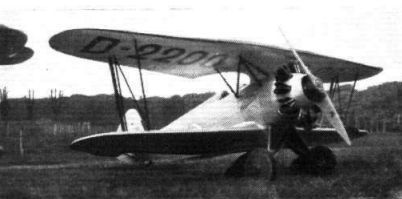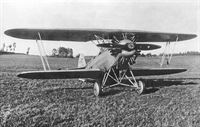
Варианты
- Raab-Katzenstein - RK.1 Schwalbe / RK.2 Pelikan / RK.9 Grasmucke - 1926 - Германия
- Raab-Katzenstein - RK.26 Tigerschwalbe - 1929 - Германия
Fieseler Fi 1, 2, 3, 4 и 5
Герхард Физелер был знаменитым летчиком-истребителем времен Первой мировой войны. В межвоенный период он стал, пожалуй, самым известным мастером воздушного пилотажа в Германии, а в 1926 году Герхард приобрел долю в компании "Raab-Katzenstein-Flugzeugwerke GmbH" (город Кассель). Компания занималась выпуском легких самолетов и владела летной школой. Физелер стал там летчиком-инструктором и убедил руководство компании построить доработанный по его спецификации один из выпускавшихся компанией бипланов Schwalbe. Самолет имел более мощную силовую установку, предназначался для выполнения фигур высшего пилотажа и получил обозначение Fieseler F 1 Tigerschwalbe.
В 1930 году Физелер приобрел компанию "Segel-Flugzeugbau-Kassel", строившую планеры, и занялся новым делом. Но уже в 1932 году он приступил к постройке оснащенных силовыми установками самолетов, переименовав компанию в "Fieseler-Flugzeugbau". Первым со стапеля сошел пилотажный биплан, предназначенный для самого Физелера и получивший обозначение F 2 Tiger. На нем Физелер выиграл мировой чемпионат по высшему пилотажу в 1934 году. Следом появились две неудачные машины - двухместная бесхвостка-моноплан с дельтовидным крылом F 3 Wespe, спроектированная доктором Александром Липпихом, и обычный двухместный легкий самолет F 4.
<...>
- Описание
Фотографии
-
Flight 1932-06 / Flight
Регистрационный номер: D-2200 MACHINES AT THE INTERNATIONAL AVIATION MEETING, ST. GERMAIN-EN-LAYE: G. Fieseler's "Tiger F.2" (340-h.p. Walter engine) which was built to his design at the Kassel Aeroplane Works.
-
Flight 1931-07 / Flight
Регистрационный номер: D-1655 RIVAL AEROBATICS: The Raab R.K. (240 h.p. Walter), flown by Dr. Hans Gullman, of Germany
-
Aviation Historian 17 / J.Forsgren - The Imperfect 10
German aerobatic champion Gerhard Fieseler with one of the Raab-Katzenstein biplanes he helped to design in the late 1920s. Fieseler would go on to win a German design competition for a STOL liaison aircraft in 1936 with his famous Storch.
-
Aviation Historian 17 / J.Forsgren - The Imperfect 10
Регистрационный номер: SE-ACO A rare head-on view of the first RK-26 to be imported into Sweden, SE-ACO, which was fitted with a 200 h.p. Armstrong Siddeley Lynx, replaced on production Sk 10s with the heavier Walter Castor IA.
-
Aviation Historian 17 / J.Forsgren - The Imperfect 10
Регистрационный номер: SE-ADK The original RK-26 SE-ACO was re-registered as SE-ADK in 1932, before being sold in 1934 to the first of a number of new owners, including the Norrkoping Automobile Flying Club and Lennart Hemminger, who donated the aircraft for use by F 19, Sweden’s volunteer unit in Finland, in early 1940.
-
Flight 1932-06 / Flight
IM RUCKENFLUG: Herr Fieseler used his new "Tiger 2" at the International Flying Meeting at Tempelhof Aerodrome, Berlin, and he appears to be equally at home either side up.
-
Air-Britain Archive 1984-02
Регистрационный номер: YR-ADN Also one of Cantacuzino’s mounts was this ICAR-Raab Tigerschwalbe YR-ADN which we would like to know more about.
-
Aviation Historian 17 / J.Forsgren - The Imperfect 10
One of the first production Sk 10s was photographed on January 25, 1934, probably just before its delivery to Flygvapnet. The Walter Castor IA seven-cylinder radial engine was of Czechoslovakian origin, the Walter company being a specialist in small three-, five-, seven- and nine-cylinder radials throughout the 1920s.
-
Aviation Historian 17 / J.Forsgren - The Imperfect 10
Retaining the Tigerschwalbe’s purposeful lines, the Sk 10 was nevertheless an entirely different animal, being considerably heavier - with a consequently higher wing loading - than its forerunner. In total, 25 examples were built, nearly three-quarters of which had been written off by the time the last example was retired in 1945.
-
Aviation Historian 17 / J.Forsgren - The Imperfect 10
An Sk 10 taxies in after a solo training flight. An attractive, well-proportioned biplane, the type nevertheless required a much higher level of skill to fly than other contemporary trainers, particularly the de Havilland Moth, which some Flygvapnet officers felt was a more suitable training machine.
-
Aviation Historian 17 / J.Forsgren - The Imperfect 10
The cockpit of Sk 10 c/n 19, serial 535, wearing the number of its unit, F 5, ahead of the national tri-crown marking, and individual code number “41” aft of it, as per standard in 1936. The controls were duplicated front and rear, and the type was intended to provide the requisite skills to convert to Flygvapnet’s Bristol Bulldogs.
-
Aviation Historian 17 / J.Forsgren - The Imperfect 10
A report on the “Tiger-Swallow” in the June 1933 issue of American magazine Popular Flying explained that “the great strength of the machine is due to the use of tubes and sheets of Swedish nickel-chrome steel. This steel has a tensile strength almost triple that of the tubing and sheet used in most aircraft”. But it was also heavier.
-
Aviation Historian 17 / J.Forsgren - The Imperfect 10
A line-up of Sk 10s at Rinkaby airfield in southern Sweden in September 1936, by which time five of the 25 had been written off in accidents, although all of the mishaps that befell the type were ascribed to pilot error, rather than an inherent design flaw in the aircraft. Despite the high attrition rate, only two people were killed in Sk 10s.
-
Air Pictorial 1973-06
Регистрационный номер: ES-AGU, ES-EHA This was taken at Tallinn airport circa 1935 and depicts aircraft of the Estonian Aero Club. They are: ES-RWD, RWD-8, a slightly modified machine constructed in Estonia; ES-EPP, OGL-2; ES-LDM, OGL-1; ES-PON, OGL-1; ES-ALF, type unidentified [Fieseler F5R]; ES-AGU, Raab Schwalbe II; and ES-EHA, Raab Schwalbe II.
Другие самолёты на фотографии: Fieseler F-4 / F-5 - Германия - 1933Post, Org, Neudorf PON-1 - Эстония - 1934Post, Org, Neudorf PON-2 - Эстония - 1934RWD RWD-8 - Польша - 1932
-
Aviation Historian 18
Inspired by our article on Sweden’s ASJA Sk 10 military trainer in TAH17, reader Ned Reif has produced this paper model. Working from the scale drawings we published, Ned employed various computer programs to create the model in flat form, then used a colour laser copier to print it on 120gsm A3 silver paper, before cutting the components out and assembling by hand.
-
Aviation Historian 17 / J.Forsgren - The Imperfect 10
The original RK-26 SE-ACO was re-registered as SE-ADK in 1932, before being sold in 1934 to the first of a number of new owners, including the Norrkoping Automobile Flying Club and Lennart Hemminger, who donated the aircraft for use by F 19, Sweden’s volunteer unit in Finland, in early 1940.
- Фотографии















